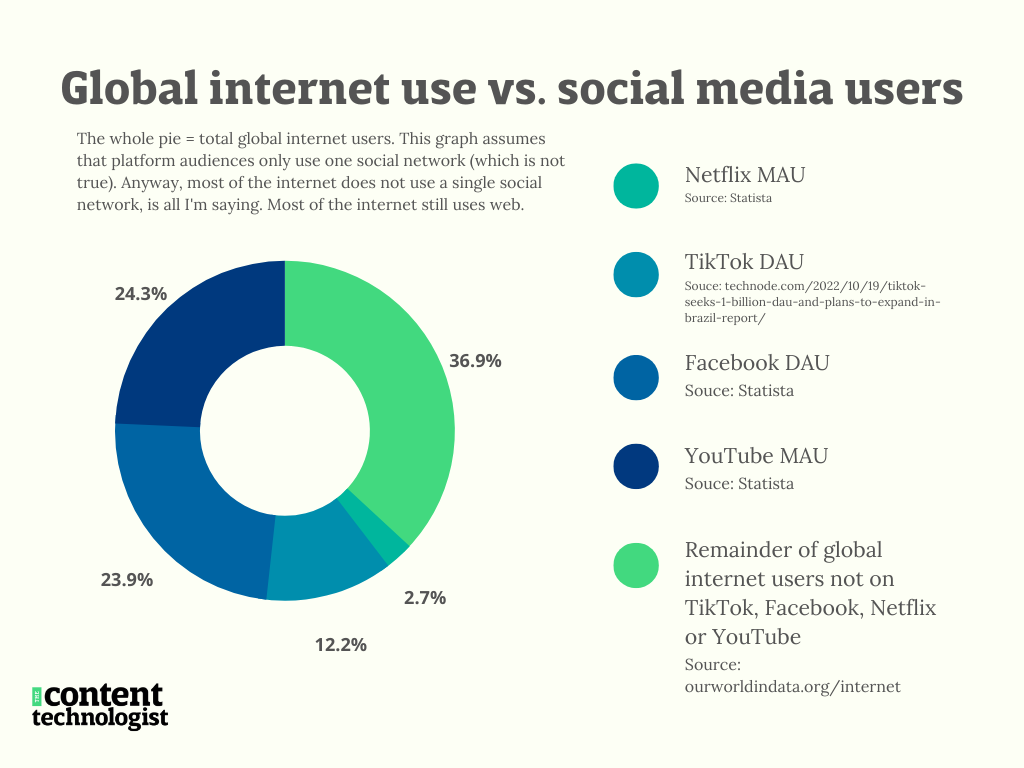A couple of weeks ago I went long about websites being expensive, a lot of work, requiring more resources than many businesses expect, and being hard to manage—all these facts are true!

Nevertheless, a website is the best possible investment for a content-forward digital publisher. A good website is worth every bit of the time, money and effort a publishing team can afford. Yes, sometimes website construction feels like an endless form-fill where you can’t make any progress even though it feels like you’ve been in the CMS for days. Web is not a shiny new medium. Publishing proper web content feels old, slow and cumbersome compared to social video you can build and publish on a phone. But websites are here to stay, and if your content business relies on building trust and connection with your audience, they are an absolute necessity.
“But wait a minute, Deborah,” you might say. “You work almost exclusively with websites. Obviously you are biased.” No shit, of course I’m biased. I’ve been building websites for 25 years. But my bias comes from practical business experience and a realistic view of information-seeking behaviors in the 21st century.
Invest in a website AND, not a website OR.
Folks who are new to digital content strategy often start with: Should I invest in my website? Or should I choose a social platform/emerging medium/newsletter/book? Should I spend time convincing my company to make its website better? My advice is the same whether you’re a leading company or a solo creator:
Invest in your website first. Then, adopt a diversified channel strategy that expands from your site’s core. It’s not an either/or, it’s a website AND other channels.
I’m not saying you should create a social/email strategy that “drives traffic to the website.” That doesn’t work. And I think an email newsletter is a great way to distribute your content to an attentive audience.
But a website gives your brand and expertise a reliable home that supports your efforts on other channels. Publishing on a website means that your content gains equity, attracts audiences and accrues value over time, which one-and-done email newsletters simply cannot provide on their own. Social channels don't resurface your content after a couple of days unless it's gone viral. If you’re going to put thought into the content, know that web content is more evergreen than anything in a feed or inbox. If you put in the work and build intentionally, with your audience in mind, a website pays back dividends.
Remember: You want your content to be discoverable from those who are actively seeking it, and a website remains the most reliable place for your audience to find you. Here are three reasons why a website remains your best-bet for establishing a website audience over time.
Everybody uses web, every day.
While social media channels inspire infinite think pieces on why I’m quitting social media, no one throws up their hands and says, “Welp, no more web for me! I’m only going to read email, books and newspapers to get my information from now on.”
Everyone uses web to shop and to search. Yes, they are largely shopping and searching within big tech monopolies, but if Google or Amazon disappeared tomorrow or, more likely, were split into smaller pieces, massive amounts of people would still use the web to search and to shop.
When I say everyone, I mean most of the world:
Yes, some may only be using WhatsApp or other social channels as a primary means of communication. Some may only watch connected tv streams or play social games. But except for the strange part of the 2000s when North America couldn’t make up its mind (according to these numbers), internet adoption—primarily through web-based means— continues steadily up and to the right.
Even the most popular walled gardens are small percentages of the total online population, who are likely introduced to web sooner or later.

Social networks, despite their best efforts to keep users on platform, watch active users decamp to web content via shared links. With few exceptions, everyone who ends up on the internet browses and searches the web, which means: they can find your website. Web remains the most globally accessible medium.
Web is an information-first medium.
Like newspapers and books in the 20th century, people search the web and visit websites to find trustworthy information. Blame Wikipedia for creating the expectation of connected facts, but web’s primary function is not social, gaming or community. Much web activity is driven by the information-seeking behaviors that power search.
I’m not saying that everyone is good at finding quality information on the web, or that quality information is present on every subject. But there is information to be found on every subject, and if you care about establishing a reputation around a particular topic, web’s the way to go if you want people to discover your expertise.
Based on the billions of people who search on the daily, all the do-your-own-researchers and student info-seekers, all the queries upon queries upon queries that I’ve perused from Google’s publicly available keyword data for a decade: people search for everything. And they search when they want to find facts.
Even if audiences spend time on TikTok or the next fast-growing platform, they turn to their web browser and search engines to confirm facts or dive deeper. Television viewers and podcast listeners do the same, albeit to a lesser extent: when they see content they want to share, they search for it on the web.
Because of this search behavior, if you’re in the business of facts, your brand website should be discoverable online. It should echo your social content strategy and provide a wide breadth of expertise. Like published books, well-managed websites with high visibility confer authority.
Audiences of digital readers still habitually visit websites.
Far too many internet users remember stumbling on delightful web content, whether it was Gurl.com, Buzzfeed in its heyday, or The Pudding today. To satisfy our screen habits, many of us are still chasing that dragon of finding the next cool thing online.
Bookmarking a website and visiting daily (or better yet, typing in a homepage URL directly) may be a behavior that dies with millennials. But goddammit, the oldest of us are only just getting to our 40s and have the best years of our digital information-seeking lives ahead of us. The behavior of seeking and visiting good, quality websites isn't dying in the next ten or twenty years.
Recent news site redesigns on The Verge and Semafor are trying to cultivate a daily addiction to their own sites and compete with Twitter by using ticker tape headline feeds. I’m iffy on that approach cos it’s too reminiscent of 24-hour cable news chyrons—and also, yuck, text overload. But they’re right about the behavior: audiences seek the comfort of a regular update from a source they trust.
Even when audiences visit social channels out of habit, it’s not guaranteed that they’ll see your content. Unless you have the knack and drive to feed social algorithms, they probably won’t see even half of what you post.
When audiences find your content first via passive entertainment channels or social networks, they aren’t necessarily looking to read or go deep. But the web is for explorers and seekers. It’s for the people who will go out of their way to find you.
Good website experiences contain only as many distractions as you choose. They let your audience opt in to resonant content. For many people, the act of discovering content on their own creates a deeper connection than being served recommendations that don’t suit their needs. For those of us who track channel performance for media planning, organic web content developed over time continues to attract the best customers and provides the highest return on investment. You’re not overshadowed by the business actions of another platform. With a website, you’re on your own home turf.
Hand-picked related content








